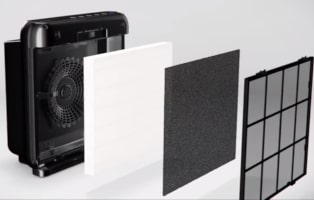Ozone air purifiers can be dangerous. Read our illuminating article so you can keep yourself and your family safe!
These days, people know that the air inside their home might be as polluted, if not more, than the air outside their home. That’s why, in the last several years, air purifiers have become a hot commodity.

One of the most touted types of air purifiers are those that generate ozone. But is ozone all that safe ? In this article, you’ll learn how ozone affects the body, what ozone air purifiers are, and alternatives to these devices.
Common Ways to Reduce Indoor Air Pollution
Before we start talking about air purifiers, let’s review the most common ways to reduce indoor air pollution:

- Source Control: This is when you reduce or eliminate air pollution at its source.
- Ventilation: By diluting and exhausting air pollution to the outdoors, you eliminate contaminants that compromise your health.
- Air Cleaning: Remove pollutants through proven air cleaning methods, including air purifiers.
The most effective method is source control because you remove toxins before they have a chance to get into the air. To do this, you’d disinfect damp surfaces, minimize humidity and moisture, and use other hygienic practices.
The second method is also reasonably effective It involves setting up air exhaust ports near possible sources of contaminants or opening windows.
Air cleaning, the third approach, is used to supplement the other two because it’s not sufficient by itself.
What is Ozone ?

We don’t breathe individual oxygen molecules—we breathe dioxygen, which is two oxygen atoms bonded together. When an electric charge is applied to dioxygen, the atoms split apart and reform into a group of three, which then becomes ozone.
As an ozone molecule wafts through the air, it might encounter a contaminant. If it does, one of the oxygen atoms breaks away and hooks up with it, neutralizing the pollutant.
This is the source of ozone’s purported power to disinfect and deodorize.
How it Harms the Human Body

Many manufacturers of air purifiers that produce ozone claim they safely clean the air. Some companies go as far as to say that these devices have been approved by the federal government for use in occupied spaces—which isn’t even remotely true.
In the stratosphere, ozone offers protection from the UV rays of the sun. On the surface of the planet, ozone is so dangerous, it’s been classified as an air pollutant by the EPA.
Ground-level ozone is even a major component of smog.
For close to a century, medical professionals have repeatedly stated that inhaling ozone can cause irreparable harm to the human body.
Today, the Food and Drug Administration mandates that ozone levels be no more than 0.05 parts per million. That’s because breathing in high ozone concentrations can cause the same type of long-term lung damage as inhaling gasoline or glue.

Dangerous ozone levels can also be produced when sunlight interacts with man-made emissions, like automobile exhaust and industrial pollution.
This can cause potentially harmful consequences to your body.
For example, if you breathe in high levels of ozone, it can damage your lungs. Other symptoms of ozone inhalation include chest pain, coughing, shortness of breath, and throat irritation.
Exercise increases the amount of ozone that gets into the lungs.
What is an Ozone Air Purifier ?
An ozone air purifier is any device that uses ozone to clean the air.
Types of Ozone Air Purifiers

HEPA/Ionic Air Purifiers with built-in ozone-generating devices use filters or electrostatic plates as their primary means of filtration. They use ozone to boost their cleaning power.
Consumer-grade personal ozone generators are devices that produce relatively high concentrations of ozone but don’t filter out particles. Commercial grade ozone generators produce high concentrations of ozone.They should never be used in a room with a person present. These are the machines used by cleaning companies after flooding, or raw sewage has leaked into your home.
You’ll have to vacate your premises for 24 to 48 hours while the cleaners clean your house.
The Impracticality of Ozone Air Purifiers
Ozone can get rid of some (but not all) indoor air contaminants. However, it can only do this at concentrations that are so high, they violate public health standards. Some ozone air purifiers produce so much ozone that they cause ozone buildups that would trigger severe smog alerts for outdoor air.

This means that if you want ozone to cleanse your indoor air, you’ll have to leave your home for at least four hours.
That’s not very practical!
No matter how high the ozone concentration, it will never eradicate biological impurities nestled in porous materials (such as duct lining or ceiling tiles). It won’t even touch carbon monoxide or formaldehyde—two of the most insidious indoor pollutants.
Furthermore, ozone does a horrible job of getting rid of odor-causing chemicals. Sure, it’ll mask body odor and other noxious smells with a fragrance reminiscent of fresh laundry, but won’t stop them at their source.
How Manufacturers Deceive You
Studies have shown that dangerous amounts of ozone can be produced even when a user follows the manufacturer’s directions. In one study, an ozone generator recommended for spaces up to 3,000 square feet was used in a 350 square feet room.

Ozone levels quickly reached 0.50 to 0.80 ppm, five to ten times public health limits, and a dangerous amount to breathe in.
Another way manufacturers trick you is that most units’ control buttons have a major flaw because the settings do not reflect proportional increases. For example, the high setting might be ten times the amount of ozone production than the medium setting.
This makes regulating the amount of ozone an almost impossible task.
Some manufacturers recommend lowering the settings if you start to smell ozone. Unfortunately, one’s ability to smell this compound varies widely from one person to another. Also, the more you’re around it, the less you’ll be able to detect its odor.
Safer Alternatives
Instead of unsafe ozone-belching machines, here are the air purifiers you should use:
- Hepa Devices: HEPA stands for high-efficiency particulate air. HEPA filters are the only type of air cleaners that meet specific EPA standards for effectiveness. A filter has to screen out 99.7% of particles that are .3 microns or larger to meet these standards. HEPA air purifiers are effective at trapping airborne particles, but they won’t remove odors, chemicals, or gases.
- Activated Carbon Technology: Activated carbon filters in these machines capture contaminants such as chemical emissions and cigarette smoke. They also trap odors. They’re even effective at sucking formaldehyde, which can be given off by carpet, wood, and upholstery from your indoor air.
- Ionized Air Purifiers: Ionized air cleaners work by generating ions, which are positively or negatively charged particles. These ions then bond with pollutant particles, which cause the particles to harmlessly fall on household surfaces or the floor.
- Combination Hepa and Activated Carbon: Air purifiers that combine HEPA filters and activated carbon technology can eliminate airborne particles while getting rid of unpleasant odors. These purifiers provide the most advanced air purification available.

Final Thoughts
Now more than ever, it’s crucial that you make sure your indoor air is as clean as it can be. That’s why you need to buy an air purifier.
Use our handy guide to make your purchase easier. There are several different types, and some are more effective than others.
Just make sure you never buy an ozone air purifier because they don’t work and can be dangerous.

Air Purifier Tips & Tricks




Ionic air purifiers can themselves create ozone. Just buy HEPA+carbon filters.
What about the Vollara Active Pure Air & Surface Pro+.
Is there a difference between a medical or industrial ozone air filter? Is a medical ozone filter OK to use in the home?
Hi Philip, we had a skunk incident in our home and can’t get the smell out. We are renting an ozone machine. Our is 3 levels but it is mostly in our tv/ kitchen area and in the foyer cathedral ceiling. Any and all suggestions and warnings would be appreciated, Blessings
I usually beat something to death before I buy so need help after four+ weeks of the search.
I’m seeking a USA manufactured high quality air purification machine dust and allergies a concern. Can you recommend a USA made one?
What do you think of these companies?: Oransi, Oasis Iadapt, Austin. Very much appreciate your opinion as I’m blond as me wife says because I have a tendency to NOT make the right decision, but she avoids mentioning this when I say, “Who did I marry?”
Living in Paradise Jack
Jenesco is the only American made ozone generator I trust (and would NEVER buy any Chinese-made one; so this is the top of my list.) They are made in New Hampshire, have excellent customer service, and will answer all your questions. For safety, I spent the weekend at a hotel and let the generator kill a fungus (ringworm) infection in my sealed up home. It must be aired out for a few hours after such in-depth cleaning. Simpler problems like cigarette smoke do NOT require such an ordeal. Leaving hour home for an hour or two — or just shutting the ozone generator in a sealed room for a bit — and then airing out well would do the trick.
Thank you for this information. I now know the facts on these products. Great advice as well!
Do you know if the Philips ac0819/10 generate ozone?